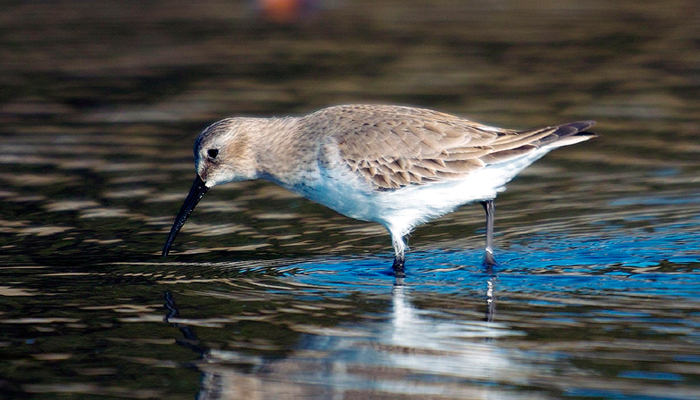
English: Dunlin
Russian: Чернозобик
Mongolian: Хар элсэг
German: Alpenstrandlaufer
French: Becasseau variable
Japanese: ハマシギ (Hama-shigi)
Body length: 17-21 cm
Wing span: 32-36 cm
Breeds on low or high ground, in wet short-grass or tundra habitats. The region’s
commonest small wader on migration (in autumn: ads. In late Jul-Aug. juvs. In
late Aug-Oct) and in winter, then found in a variety of marshy or coastal
habitats, but most numerous on tidal flats or on banks of seaweed on shallow
shores.
Identification: Familiarity
with different Dunlin plumages will provide yardstick against other species. It
will also help in initially picking out other species as ‘something different’.
Just under Starling-sized wader with variable bill length (see Variation), the
shortest and straightest almost stint-like, the longest and most decurved
approaching Curlew Sandpiper.
- Adult summer: Black belly patch diagnostic;
variable rufous on mantle/scapulars, becoming more obvious through wear; ♂
brighter than ♀, with contrasting pale grey nape (brownish on ♀).
- Adult winter:
Drab and rather featureless plumage is in itself rather distinctive, combining
plain brownish-grey upperparts (fine whitish fringes, esp. on wing-coverts);
rather clear-cut pale grey breast-band contrasting with white belly and finely
streaked or clear white flanks; rather plain head with indistinct short
supercilium; and usually fairly long decurved black bill (but beware long and
short extremes).
- Juvenile: Dark brown above, neatly fringed pale rufous or rich
rufous, usually with white scapular-and mantle –Vs; pattern of underparts
distinctive, with neat breast-band of diffuse streaks and band of rather bold
blackish spots on belly-sides leaving broad, usually unmarked white flank-band;
whole head, nape and upper breast washed ginger, without obvious supercilium:
even at long range, therefore, shows distinctive combination of rather plain
gingery head, spotted belly-sides and white flank-band. Note variability of
belly-side spotting, from often very dense (easily confused with moulting adult
summer) to very rarely totally lacking.
- Variation: Three subspecies occur
within treated region, differing in average bill length and brightness of
rufous on upperparts: arctica (Greenland; winters mainly W Africa)
shortest-billed, least rufous; schinzii (Iceland, W Europe; winters mainly W
Africa) intermediate bill length ans rufousness; and alpina (Arctic; winters W
Europe, Mediterranean) longest-billed, richest rufous. Only extreme individuals
safely identifiable; ♀♀ average longer-billed than ♂♂, so shortest-billed
individuals probably ♂ arctical schinzii, and longest-billed probably ♀ alpina.